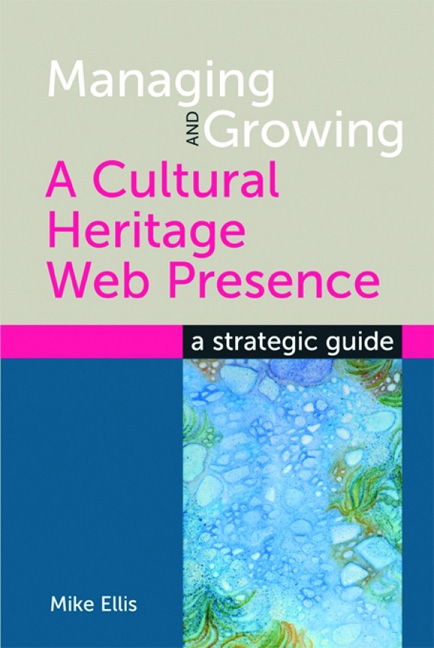Book contents
- Frontmatter
- Dedication
- Contents
- Acknowledgements
- Glossary
- Introduction
- 1 Evaluating what you have now
- 2 Building a strategic approach
- 3 Content
- 4 Marketing
- 5 Policies and guidelines
- 6 Traffic and metrics
- 7 The social web (Web 2.0)
- 8 The website project process
- 9 Away from the browser
- 10 Bringing it all together
- Bibliography
- Index
1 - Evaluating what you have now
Published online by Cambridge University Press: 08 June 2018
- Frontmatter
- Dedication
- Contents
- Acknowledgements
- Glossary
- Introduction
- 1 Evaluating what you have now
- 2 Building a strategic approach
- 3 Content
- 4 Marketing
- 5 Policies and guidelines
- 6 Traffic and metrics
- 7 The social web (Web 2.0)
- 8 The website project process
- 9 Away from the browser
- 10 Bringing it all together
- Bibliography
- Index
Summary
Introduction
Before you can begin to understand how to move your web presence forward, it is important that you understand what you have now. This not only means having a full knowledge of your current website(s) – their size, scope, number of authors, amount of content and so on – but also having a clear view of the current landscape within which your heritage organization operates, both online and offline.
The role of institutions on the web changes constantly, and has been changing since they first started being online. Initially, organizations often find themselves online almost by accident, usually as a result of an enthusiastic staff member spending some of their spare time uploading basic web pages to a server somewhere. Very often, the growth of a site follows an organic path, particularly in its early days: as enthusiastic and web-literate staff members arrive at the organization, interest and competency grows; then as they leave, the site stultifies.
Typically, sites move from this early phase into one where organizational perspectives about the web shift from niche activity into something else – if not core, at least morecore to the day-to-day activities of the institution. As organizations began to understand the potential the web offered to widen reach and access to their assets, so the activity of ‘doing the web' became more central, too. The stakeholders in these institutions now mostly (although not always – we'll come to that later…) see a strong web presence as being an integral part of the other activities they carry out day to day.
To make things more complicated, the ‘new organization’ online isn't any longer an X-paged walled-garden entity which has boundaries and well understood rules. Instead, with the advent of Web 2.0 and other third-party services, museums and heritage organizations are moving towards a much looser aggregate of pieces of content and functionality. Even if you don't actively engage in setting up these third-party sites, you'll probably find that someone else has – and here is one of the biggest challenges that the social web brings. Getting a handle on ‘external’ content like this is an increasingly important part of any web manager's role. Again, we'll look at this in more depth in Chapter 7 ‘The social web (Web 2.0)’.
- Type
- Chapter
- Information
- Managing and Growing a Cultural Heritage Web PresenceA strategic guide, pp. 1 - 20Publisher: FacetPrint publication year: 2011



